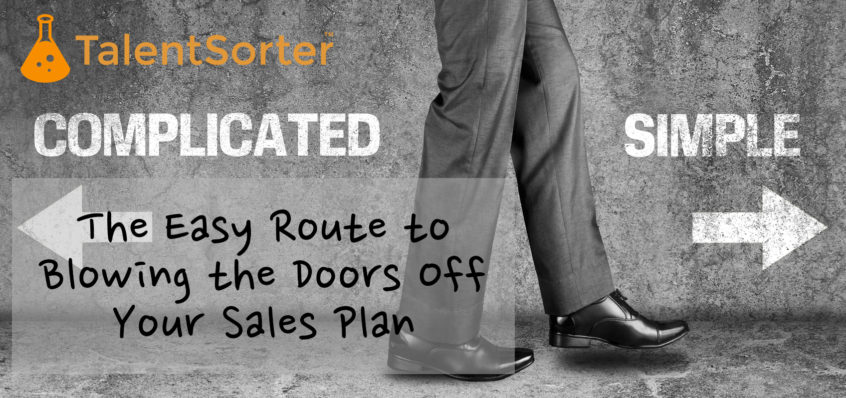Truth is, that’s likely the defect rate in your company’s hiring decisions. If your organization is normal, your hit rate – unqualified success for both the organization and the new hire, where the new employee becomes a solid contributor – is about 20%. One in five.
Most people spend more time and effort to check the specs on a $5,000 copier they are considering buying for the office than they do to research whether a $60,000 candidate has what it takes to deliver the goods. For some reason, “okay” and “gut feel” seem to be acceptable metrics in hiring. Right alongside “he had a great résumé” and “she could start Monday”.
As we conduct research in organizations, we find that the old 80/20 is actually closer to a 16/60 rule… the top 16% of the salespeople generally produce about 60% of the sales. And vice versa (this should make you wince) – 84% generally produce 40%. Do the math in your own organization and see what you come up with.
Worse still, no amount of training, workshops and ‘management’ of the folks at the bottom of the heap seems to move them from the bottom of the performance curve to the top… it’s generally not knowledge of the ‘how to’ that is missing. What’s missing is fit in the role, and it’s that fit that most HR departments and hiring managers haven’t figured out how to screen for.
Which explains why the 16/60 rule is alive and well.
Improve performance by shifting your view of performance
There are two exercises we invite new clients to work through as a means of getting them to think differently about the performance of their sales team. All sales managers (it’s almost as if they teach this at sales school) seem to categorize their team into three buckets. The labels on the buckets vary, but for the sake of the exercise let’s call them ‘stars’, ‘so-so’ and ‘passengers’. Most often, the process of assignment is somewhat subjective; here are two ways to sharpen your approach:
- One approach (illustrated here) is to divide the total sales revenue, not the sales team, into thirds. This is a very revealing exercise. Let’s say a team has annual sales of $6MM, broken into equal thirds of $2MM. Then ask the sales manager to rank individual sales performance on the team and calculate how many of their top performers it takes to capture the first third of revenue – it’s rarely more than 2-3 people. Then have them attribute the next $2MM to the next-best performers; the final third falls to the rest of the sales team.
Approached in this manner, the list of stars, so-so and passengers suddenly looks very different than the original list made by the manager… and brings with it enormous implications when you challenge them to calculate what it’s worth to his topline sales number to replace a passenger with a so-so performer, or a so-so with a star. The numbers are staggering.
- Wendell Williams, in anarticle on ere.net recently, advocates a slightly different approach to calculating the true ‘cost of average’:
Low producers burn through potential clients and drain cash faster than a career politician. As an example, take a 10-person sales force generating 5 million in sales. Four folks generate about 4 million and the rest generate about 1 million. Sales costs are budgeted at 10% of revenue, or about $500,000. The top four salespeople earn twice the commissions as their low-producing brothers and sisters. Assuming everything else is constant, we want to discover how much the bottom six sales people really cost.
Start by allocating sales costs by producer; that is, $500,000 /((4 people times 2x) + (6 people times 1x)) = 35.7K. Using this figure, we learn the top sales group costs $285,714 (4 x 35.7K x 2) and the bottom costs $214,285 (6 x 35.7K x 1). Next, we’ll calculate sales as a percentage of revenue. Top sales = 7 cents on the dollar ($285,714 expense/4mm revenue). Bottom sales = 21 cents ($214,285 expense/1mm revenue).
Our oversimplified math shows the bottom group costs three times the top group and generates 3 million less revenue. And, we have not even added the cost of recruiting, training, coaching, turnover, lost sales, poor customer service, and so forth.
Please, do anything but what you’ve been doing until now.
No sales manager worth her salt will accept the implications of either exercise. The results are clear – the best way to improve sales is to hire more people who look just like your top performers. But the question of just what’s in that ‘secret sauce’ – what it is that distinguishes your stars from your passengers – isn’t easy to answer without the right instrument.
Many sales managers insist they “know ‘em when they see ‘em!” in spite of the ranking exercise that provides plenty of evidence to the contrary. Gut, ‘curb appeal’ and intuition have generated the mixed bag of results they’ve been getting. The only way to be deliberate about building a team who look most like your stars is to use a reliable psychometric assessment that will give you the information you need to make the right decisions.
We can help with instruments that provide a detailed analysis of the factors that make your top producers what they are and shows specifically where the rest of the team need coaching and development. As a hiring tool, this assessment helps you identify sales candidates who share the same attributes as your top people, eliminating costly hiring mistakes.
Unless you’re prepared to burn a lot of leads and leave your brand in the hands of your least competent representative, you really don’t have much choice. It’s time to raise your standards of performance.
[vc_row][vc_column][rd_cta style=”rd_cta_2″ title=”Try Our Scientific Solution to Successful Hiring” left_border_color=”#04bdce” button_text=”FREE TRIAL” button_link=”https://www.talentsorter.com/free-trial/” target=”_self” button_color=”#ffffff” button_bg_color=”#04bdce”]With our Software You’ll Spend 80% Less Time Sorting through Resumes, 70% Less Time Interviewing, and Reduce Turnover 20-60%! Start a FREE TRIAL (no credit card required)[/rd_cta][/vc_column][/vc_row]
